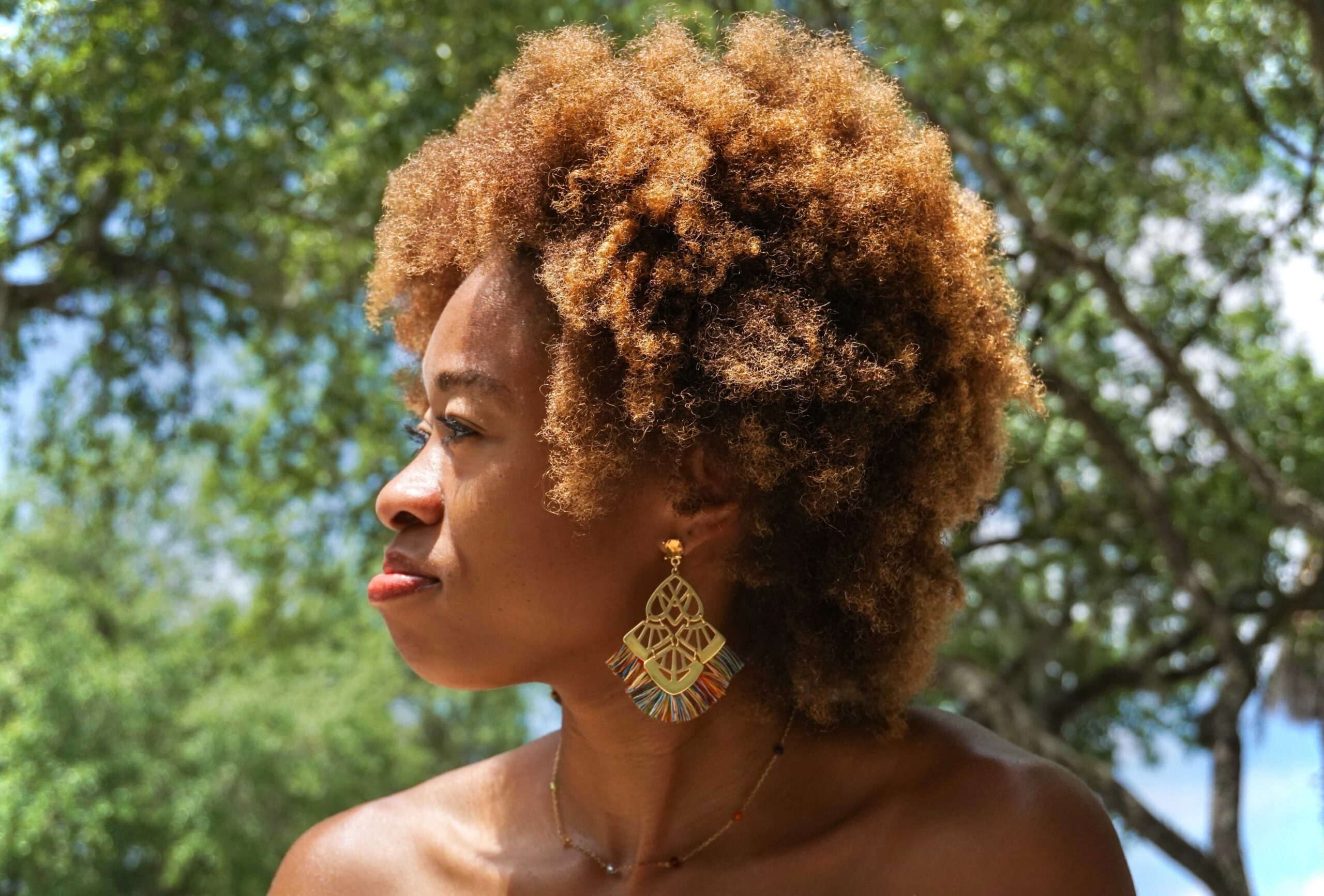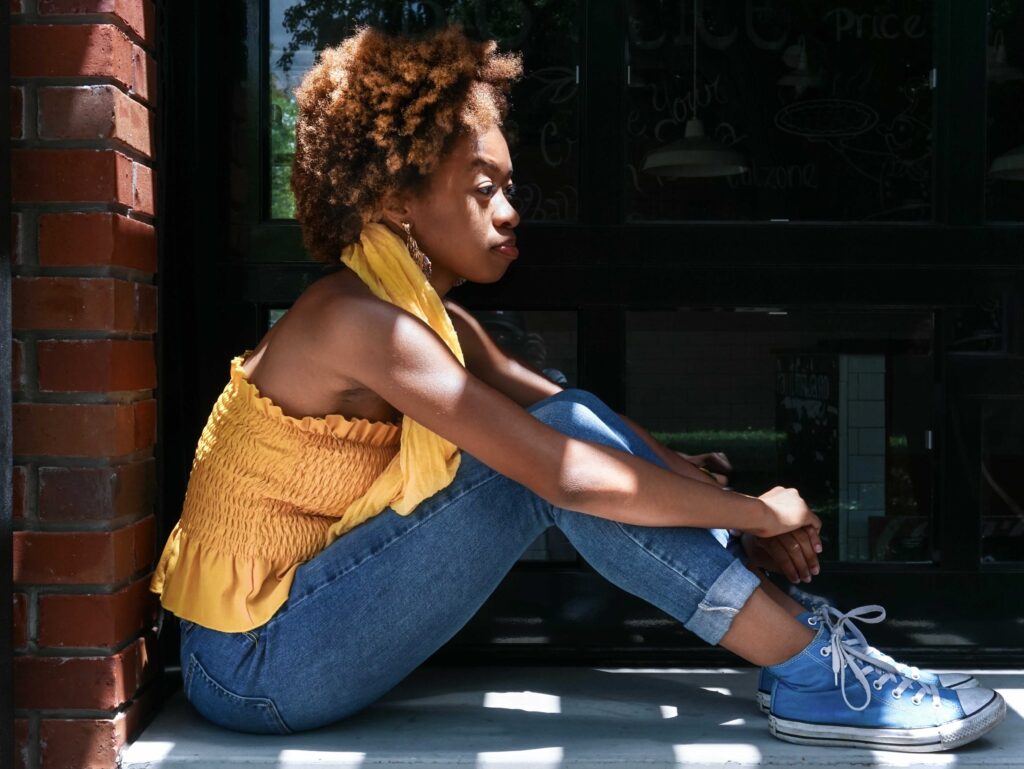How a Black woman blossomed and embraced her identity

Photo of the author, Kalia Richardson. (Walter Harwood/Atrium)
May 3, 2021 | Story by Kalia Richardson | Photos by Walter Harwood
The moment my hair sprouts from my scalp, it spins. It always has. In a daze, it reaches for a resting place and finds itself in a bed of coil-like, kinky strands. Lots of it. So tightly packed that it resembles the tip of a dry-erase marker.
It recoils from the sting of the rain and glistens in the sun. Its limbs stretch like the stem of a beanstalk, then bend quickly at the elbow, forming a spiral. It doesn’t know any better, and it took me some time to realize its beauty. My hair is part of my identity, and I have come to nurture it as a gardener would a rose garden.
I have 4C hair, the bottom of the hair food chain. That is to say, my hair is wiry, densely packed and prone to shrinkage and breakage. It’s thick like orange juice — with the pulp. It’s knotted like the shoelaces hanging from a powerline. Not like Zendaya or Tracee Ellis Ross whose tresses spring from their shoulders as they walk, but stiff as if waiting to exhale.
Only when drugged with a cocktail of oils, creams and custards, does my hair begin to dance up and down the nape of my neck — if there’s a breeze. This style is achieved after wash day: a choreographed routine that begins with sectioning, combing, washing and deep conditioning and ends with fingers webbed with edge control and tennis-ball-sized clumps of hair spotting the floor.
I wanted inches like Sasha, my Bratz doll, who had glossy black hair and plump lips like mine. The Eurocentricity encapsulating me drove my desire for long hair.
It was my predominantly white day care, my predominantly white elementary school, my predominantly white middle school and my predominantly white high school that made me question the hair follicles on my head. In Mrs. Huber’s Happy Faces kindergarten class, girls wore silky bows and loose curls. I wore braids, close to 12 of them, that stuck out like antennas. If it wasn’t braids, it was about 15 cornrows slicked to the back with Gymboree hair ties or six meaty twists that hung like caterpillars.
I wanted my classmate’s hair and believed I could somehow achieve it. I’d stand in the mirror watching beauty YouTubers create messy buns and beach waves. I’d play the video again. And then again. Oh, I missed that step. This time I’ll get it, I thought.
A half an hour passed. My eyes swelled. My arms grew sore and strained from many failed attempts before I quit. Only under immense heat would my hair appear straight, and that was reserved for special occasions. I distinctly recall my hair for my eighth-grade dance.
My toes dangled from the highchair. This time I’d look like Sasha, I thought. She begins batch one. My hair gasps for air as the flat iron wraps its dirty, black fingers around each strand, strangling each curl until it goes limp. Batch two. I wince. The hot iron taps my scalp. “I have to get as close as I can, sweetheart,” says Liz, my hairstylist. Batch three. My eyes shut. We’re almost done. Batch four.
This became clockwork. My hair was straight for my parents’ 10-year vow renewal, my cousin Sheldon’s wedding in Jamaica, my 16th birthday and my high school senior pictures. My demeanor would change as my hair slid into a spaghetti-straight coma, my mother said. I bubbled with excitement until my hair shook hands with saltwater or humidity. No matter how much heat you apply or how many hours were spent in the highchair, the roots returned the same: kinky.
Although I never permed my hair, I faced an internal dilemma. As I attempted to love and obey my God-given texture, I faced daily reminders that my natural hair was not socially acceptable. Black hair existed only in an altered state so that my white counterparts could gawk at its size and texture, so Alexandra in Mrs. Seupersaud’s Advanced Placement literature class could slip her index finger into my greased hair, so the kid in the hallway could yank my twists that my mother spent two hours styling the night before.
I am a Black goddess in my mother’s eyes. Not low-hanging fruit but a ripened mango craved by anyone who reached yet failed to grasp it. While my mother projected messages of hair love, she waltzed into the salon every two months to have her hair parted, conditioned and relaxed — a process that permanently straightens one’s hair. Within weeks, it became frail, thirsting for another glass of relaxer. Straight hair for a 15-year-old in St. Andrews, Jamaica, meant acceptance and class, my mother said.
Young, Black girls are taught Black hair is not real hair but wool. On the other hand, store-bought hair that resembled the whitewashed models in magazines and films is neat and easy to manage. Young, Black girls like myself learned that whiteness established the framework of beauty, and without question, we all believed it.
Only when we rescue ourselves from the media’s unitary perception of beauty will we begin to see it in ourselves. I realized I could not part with my unruly ends in my senior year of high school.
I chose a ’fro for prom. My mother wielded a pink-toothed hair pick, adding more volume and texture with every stroke. Along with my gravity-defiant halo was an off-the-shoulder cherry gown that hugged and kissed my cedar-colored skin, paired with gold earrings that tiptoed on my collar.
Some stared, others appreciated. Like the great Black women who led the Black liberation movement, fists raised to the heavens, I no longer needed the validation of my critics and white counterparts.
I dabbled with auburn, gold and brown dyes. I entered the ring of box braids in 2019, a protective style that feeds in synthetic hair to form long braids. I sat crisscross on my cousin Jessica’s living room floor as she added Kanekalon hair for six hours. I began wearing headwraps in Meyer lemon shades and decorative prints.
Unclean, unkempt and ugly do not define Black hair and should not creep into the minds of young, Black girls who are beginning to develop self-esteem and self-worth. I encourage them to recognize their hair as a coiled crown resting valiantly on their heads, demanding utmost respect.
The girl who once fell victim to the punches thrown by societal pressures bloomed and has not stopped sprouting since. I stepped over my wilted soul, who drank from the poisoned cup of self-loathing, and claimed space for my new, unapologetic hair identity.

Photo of the author, Kalia Richardson. (Walter Harwood/Atrium)
A lovely read, raw yet coming from your heart! Thoroughly enjoyed this essay!